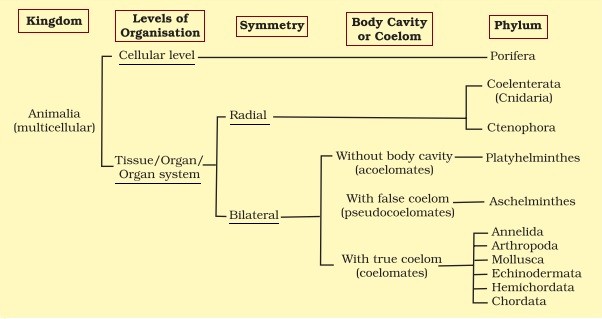Man is an animal. You certainly know that. A frog is also an animal and you also know that. but, are man and frog similar? No! But, why? When both of them belong to the kingdom Animalia, why all these differences? Therefore, in this chapter, we will study the animal kingdom for more details. We will understand why there is so much difference between various animals.
Suggested Videos
Attributes of Animalia Kingdom Classification
The animalia kingdom consists of various multicellular eukaryotic animals. It is one of the kingdoms among the five kingdom scheme of classification (by Whittaker).
What is the Basis of Classification?
There are a few important characteristics that are regular to different organisms. Therefore, it is important for us to know about the various components. These components include body symmetry, nature of coelom, the arrangement of cells, notochord, patterns of circulatory, digestive and reproductive frameworks, segmentation and an arrangement of cells in germ layers. Now we will look at these components in details.
Levels of Organization
Every organism of the Animalia kingdom is multicellular. However, they don’t display the same example of cell organization. The examples of cellular organization found in animals are:
- Cellular Level of Organization – In such animals, the cells are organized as free cell lumps. We can see this sort of cellular organization in sponges. Illustration: Sponges.
- Tissue Level of Organization – Animal cells shows the division of exercises amid themselves. Cells carrying out the same capacity are organized as tissues. Illustration: Coelenterates.
- Organ Level of Organization – We group the animal tissues carrying out similar capacity into shape organs. Every organ is specific for particular capacity. Illustration: Platyhelminthes.
- Organ framework Level of Organization – In animals where organs have related to shape functional frameworks where every framework is related to a particular physiological capacity, display organ framework level of organization. Examples include Molluscs, Chordates and Annelids etc.

Patterns of Organ Systems
Organs frameworks in various animal groups display different examples of complexities.
- Digestive System – There are two forms of digestive framework Complete and Incomplete Digestive Framework.
- Incomplete Digestive Framework – This form of digestive system has one and only opening to the outside of the body, i.e., a solitary opening serving as both mouth and rear-end. Hence, the digestive system is incomplete.
- Complete Digestive Framework – In this form there are two different openings to the outside of the body, a mouth and a rear-end.
- Circulatory System – Circulatory framework might be of two sorts
- Open Type – In open sort circulatory framework the blood is pumped out of the heart and all the cells and tissues are straightforwardly washed in it. Hence, the circulatory system is open.
- Closed Type – In this kind of circulatory framework, the blood flows through a progression of vessels of varying size and diameters. These include the veins, arteries, and capillaries.
You can download Biological Classification Cheat Sheet by clicking on the download button below

Body Symmetry
We can categorise animals on the basis of the symmetry of their body. The course of action of body parts around a mainline or point decides the symmetry.
- Asymmetrical: We can’t partition these animals into two equivalent parts along with any plane going through their focal point. Example: Sponges.
- Radial Symmetry – Animals tend to display spiral symmetry. This means that any plane going through the focal pivot of the body partitions the organism into two indistinguishable parts. Example: Ctenophores and Echinoderms.
- Bilateral Symmetry – Animals, where the body can be partitioned into indistinguishable right and left parts, are bilaterally symmetrical. Example: Annelids, Arthropods, etc.
Notochord
Chordates are the animals with a notochord. On the other hand, non-chordates are the animals lacking a notochord. Example: Porifera to Echinoderms.
System of Classification of Animal Kingdom
There is a wide range of animals which are comparative and distinctive to each other in numerous angles. Therefore, individuals from a specific group of animal share a specific trademark. This is the component that characterizes the group.
Swedish botanist Carolus Linnaeus (1707-1778), discovered Modern System of Scientific Classification. The frameworks most researcher use classify every living thing into seven groups or taxons. These classifications in the hierarchical framework are from top most and most comprehensive to the lowest and more particular are:
- Kingdom – Kingdom is the most astounding essential division in which all articles are set. The Animal Kingdom involves all animals in the world.
- Phylum – We can separate each kingdom into smaller subdivisions called phyla. For example, Chordates are a phylum with individuals having the notochord.
- Class – We can separate chordates into classes. For example Mammalia, Birds, Reptilia, and Amphibians.
- Family – We can divide classes into families. Families contain more than one genus.
- Genus – Families are sub-partitioned into genera. Animals that have the same genus are fundamentally the same.
- Species – Species is the most crucial and contains only one kind of animal.
Learn more about Kingdom Protista here.








What is an example of liverwort
What is the example of liverwort